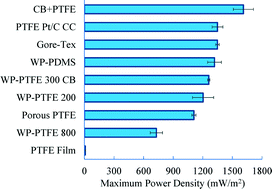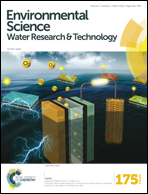Diffusion layer characteristics for increasing the performance of activated carbon air cathodes in microbial fuel cells
Abstract
The characteristics of several different types of diffusion layers were systematically examined to improve the performance of activated carbon air cathodes used in microbial fuel cells (MFCs). A diffusion layer of carbon black and polytetrafluoroethylene (CB + PTFE) that was pressed onto a stainless steel mesh current collector achieved the highest cathode performance. This cathode also had a high oxygen mass transfer coefficient and high water pressure tolerance (>2 m), and it had the highest current densities in abiotic chronoamperometry tests compared to cathodes with other diffusion layers. In MFC tests, this cathode also produced maximum power densities (1610 ± 90 mW m−2) that were greater than those of cathodes with other diffusion layers, by 19% compared to Gore-Tex (1350 ± 20 mW m−2), 22% for a cloth wipe with PDMS (1320 ± 70 mW m−2), 45% with plain PTFE (1110 ± 20 mW m−2), and 19% higher than those of cathodes made with a Pt catalyst and a PTFE diffusion layer (1350 ± 50 mW m−2). The highly porous diffusion layer structure of the CB + PTFE had a relatively high oxygen mass transfer coefficient (1.07 × 10−3 cm s−1) which enhanced oxygen transport to the catalyst. The addition of CB enhanced cathode performance by increasing the conductivity of the diffusion layer. Oxygen mass transfer coefficient, water pressure tolerance, and the addition of conductive particles were therefore critical features for achieving higher performance AC air cathodes.

- This article is part of the themed collection: Environmental Science: Water Research & Technology 2016 Most Downloaded Articles


 Please wait while we load your content...
Please wait while we load your content...